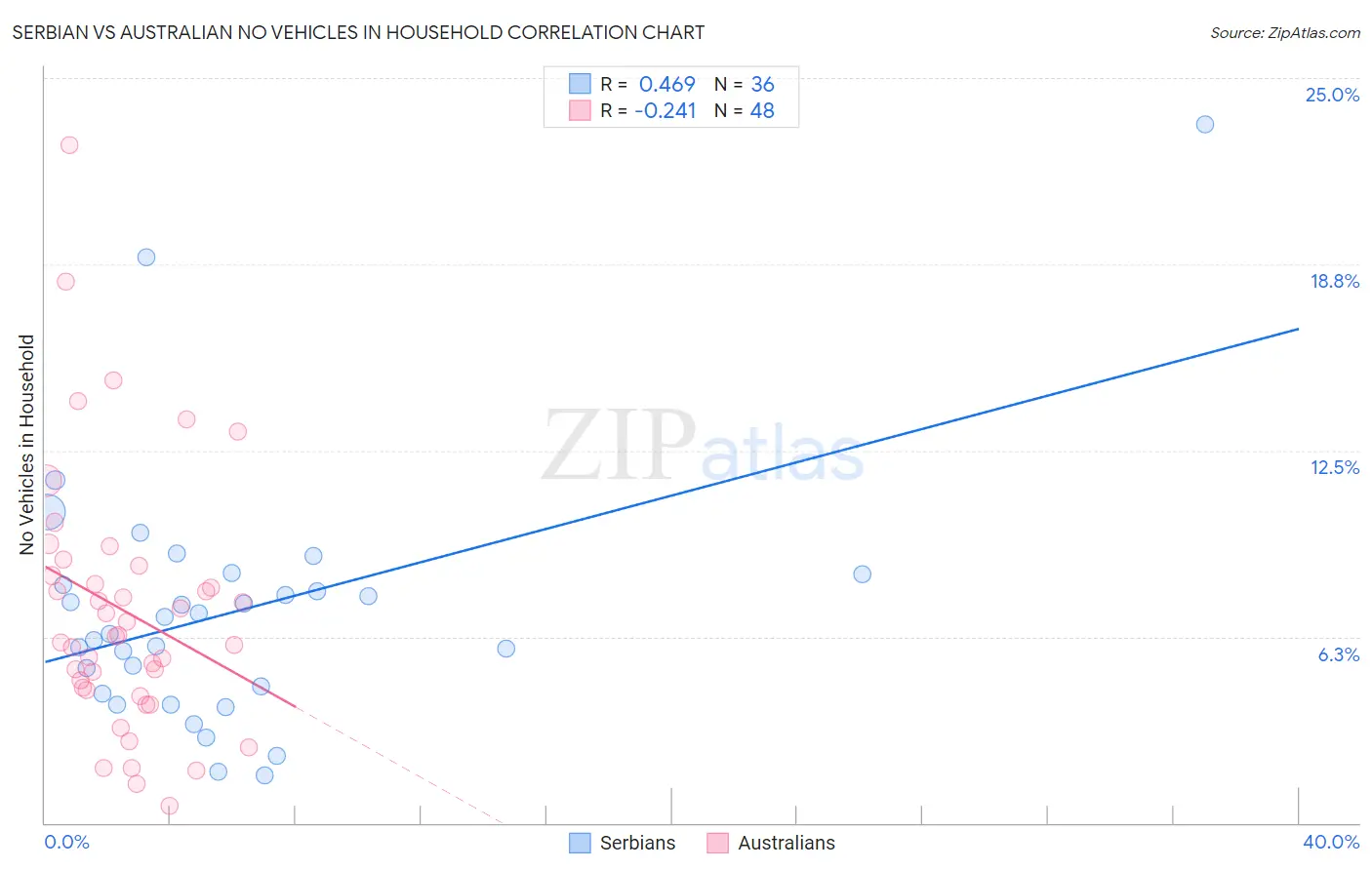Serbian vs Australian No Vehicles in Household
COMPARE
Serbian
Australian
No Vehicles in Household
No Vehicles in Household Comparison
Serbians
Australians
9.4%
NO VEHICLES IN HOUSEHOLD
94.3/ 100
METRIC RATING
114th/ 347
METRIC RANK
10.1%
NO VEHICLES IN HOUSEHOLD
70.6/ 100
METRIC RATING
157th/ 347
METRIC RANK
Serbian vs Australian No Vehicles in Household Correlation Chart
The statistical analysis conducted on geographies consisting of 267,180,680 people shows a moderate positive correlation between the proportion of Serbians and percentage of households with no vehicle available in the United States with a correlation coefficient (R) of 0.469 and weighted average of 9.4%. Similarly, the statistical analysis conducted on geographies consisting of 223,715,583 people shows a weak negative correlation between the proportion of Australians and percentage of households with no vehicle available in the United States with a correlation coefficient (R) of -0.241 and weighted average of 10.1%, a difference of 7.2%.

No Vehicles in Household Correlation Summary
| Measurement | Serbian | Australian |
| Minimum | 1.6% | 0.57% |
| Maximum | 23.5% | 22.8% |
| Range | 21.9% | 22.2% |
| Mean | 7.1% | 7.1% |
| Median | 6.6% | 6.3% |
| Interquartile 25% (IQ1) | 4.5% | 4.5% |
| Interquartile 75% (IQ3) | 8.2% | 8.5% |
| Interquartile Range (IQR) | 3.7% | 4.0% |
| Standard Deviation (Sample) | 4.2% | 4.4% |
| Standard Deviation (Population) | 4.2% | 4.3% |
Similar Demographics by No Vehicles in Household
Demographics Similar to Serbians by No Vehicles in Household
In terms of no vehicles in household, the demographic groups most similar to Serbians are Navajo (9.4%, a difference of 0.070%), Japanese (9.4%, a difference of 0.13%), Chippewa (9.4%, a difference of 0.30%), Immigrants from Netherlands (9.4%, a difference of 0.43%), and Armenian (9.4%, a difference of 0.52%).
| Demographics | Rating | Rank | No Vehicles in Household |
| Hispanics or Latinos | 97.7 /100 | #107 | Exceptional 9.1% |
| Mexican American Indians | 97.6 /100 | #108 | Exceptional 9.1% |
| Maltese | 97.6 /100 | #109 | Exceptional 9.1% |
| Delaware | 97.2 /100 | #110 | Exceptional 9.2% |
| Immigrants | Kuwait | 95.1 /100 | #111 | Exceptional 9.4% |
| Armenians | 95.0 /100 | #112 | Exceptional 9.4% |
| Immigrants | Netherlands | 94.8 /100 | #113 | Exceptional 9.4% |
| Serbians | 94.3 /100 | #114 | Exceptional 9.4% |
| Navajo | 94.2 /100 | #115 | Exceptional 9.4% |
| Japanese | 94.1 /100 | #116 | Exceptional 9.4% |
| Chippewa | 93.8 /100 | #117 | Exceptional 9.4% |
| Greeks | 92.9 /100 | #118 | Exceptional 9.5% |
| Fijians | 92.7 /100 | #119 | Exceptional 9.5% |
| Immigrants | Thailand | 92.6 /100 | #120 | Exceptional 9.5% |
| Puget Sound Salish | 92.4 /100 | #121 | Exceptional 9.5% |
Demographics Similar to Australians by No Vehicles in Household
In terms of no vehicles in household, the demographic groups most similar to Australians are Immigrants from Micronesia (10.1%, a difference of 0.050%), Spanish American Indian (10.1%, a difference of 0.060%), Immigrants from Indonesia (10.1%, a difference of 0.21%), Salvadoran (10.1%, a difference of 0.30%), and Sioux (10.1%, a difference of 0.31%).
| Demographics | Rating | Rank | No Vehicles in Household |
| Colombians | 73.9 /100 | #150 | Good 10.0% |
| Immigrants | Eastern Africa | 73.8 /100 | #151 | Good 10.0% |
| Immigrants | Congo | 73.0 /100 | #152 | Good 10.1% |
| Tlingit-Haida | 72.5 /100 | #153 | Good 10.1% |
| Sioux | 72.4 /100 | #154 | Good 10.1% |
| Salvadorans | 72.4 /100 | #155 | Good 10.1% |
| Immigrants | Micronesia | 70.9 /100 | #156 | Good 10.1% |
| Australians | 70.6 /100 | #157 | Good 10.1% |
| Spanish American Indians | 70.2 /100 | #158 | Good 10.1% |
| Immigrants | Indonesia | 69.3 /100 | #159 | Good 10.1% |
| Immigrants | Middle Africa | 65.7 /100 | #160 | Good 10.2% |
| New Zealanders | 65.1 /100 | #161 | Good 10.2% |
| Immigrants | Austria | 64.4 /100 | #162 | Good 10.2% |
| Immigrants | Cambodia | 63.7 /100 | #163 | Good 10.2% |
| South Africans | 61.1 /100 | #164 | Good 10.2% |